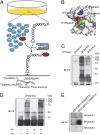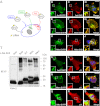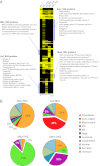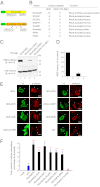Modified SH2 domain to phototrap and identify phosphotyrosine proteins from subcellular sites within cells
- PMID: 23027962
- PMCID: PMC3491470
- DOI: 10.1073/pnas.1207358109
Modified SH2 domain to phototrap and identify phosphotyrosine proteins from subcellular sites within cells
Abstract
Spatial regulation of tyrosine phosphorylation is important for many aspects of cell biology. However, phosphotyrosine accounts for less than 1% of all phosphorylated substrates, and it is typically a very transient event in vivo. These factors complicate the identification of key tyrosine kinase substrates, especially in the context of their extraordinary spatial organization. Here, we describe an approach to identify tyrosine kinase substrates based on their subcellular distribution from within cells. This method uses an unnatural amino acid-modified Src homology 2 (SH2) domain that is expressed within cells and can covalently trap phosphotyrosine proteins on exposure to light. This SH2 domain-based photoprobe was targeted to cellular structures, such as the actin cytoskeleton, mitochondria, and cellular membranes, to capture tyrosine kinase substrates unique to each cellular region. We demonstrate that RhoA, one of the proteins associated with actin, can be phosphorylated on two tyrosine residues within the switch regions, suggesting that phosphorylation of these residues might modulate RhoA signaling to the actin cytoskeleton. We conclude that expression of SH2 domains within cellular compartments that are capable of covalent phototrapping can reveal the spatial organization of tyrosine kinase substrates that are likely to be important for the regulation of subcellular structures.
Conflict of interest statement
The authors declare no conflict of interest.
Figures








References
-
- Schirmer EC, Florens L, Guan T, Yates JR, 3rd, Gerace L. Nuclear membrane proteins with potential disease links found by subtractive proteomics. Science. 2003;301:1380–1382. - PubMed
-
- Foster LJ, et al. A mammalian organelle map by protein correlation profiling. Cell. 2006;125:187–199. - PubMed
-
- Blume-Jensen P, Hunter T. Oncogenic kinase signalling. Nature. 2001;411:355–365. - PubMed
-
- Rikova K, et al. Global survey of phosphotyrosine signaling identifies oncogenic kinases in lung cancer. Cell. 2007;131:1190–1203. - PubMed
Publication types
MeSH terms
Substances
Grants and funding
LinkOut - more resources
Full Text Sources
Other Literature Sources
Molecular Biology Databases
Miscellaneous

